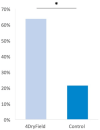Improvement in Fertility and Pain after Endometriosis Resection and Adhesion Prevention with 4DryField® PH: Follow-up of a Randomized Controlled Clinical Trial
- PMID: 37240703
- PMCID: PMC10218949
- DOI: 10.3390/jcm12103597
Improvement in Fertility and Pain after Endometriosis Resection and Adhesion Prevention with 4DryField® PH: Follow-up of a Randomized Controlled Clinical Trial
Abstract
Background: Adhesions after endometriosis resection are frequent and the most common causes for chronic pain and secondary infertility. Primary results of our randomized controlled trial (RCT) on adhesion prevention after deep infiltrating endometriosis (DIE) resection using the gel barrier 4DryField® PH showed 85% adhesion reduction in second-look surgeries. Secondary endpoint data on fertility and pain development were collected during 12-month follow-ups.
Methods: This RCT comprised 50 patients. Preoperatively and after 1, 6 and 12 months, pain scores for cycle-independent pelvic pain, dysmenorrhea, dyspareunia, dyschezia, and dysuria, as well as the number of pregnancies, were recorded,.
Results: The pregnancy rate in the intervention group was significantly higher (p < 0.05). Pain development was also improved: after 12 months, all 5 subscores were lower in the intervention group and improvements were more pronounced, most prominently concerning cycle-independent pelvic pain and dysmenorrhea, the two subcategories with the highest preoperative scores and, therefore, the highest relevance for the patients. Cycle-independent pelvic pain even recurred in the control group, while barrier application prevented this.
Conclusions: Considering the known causal link between adhesions and pain, it is apparent that the favourable outcomes in the intervention group are linked to effective adhesion prevention. The significant increase in pregnancies is remarkable.
Keywords: adhesion prophylaxis; barrier gel; clinical study; cycle-independent pelvic pain; dysmenorrhea; fertility; laparoscopy; pregnancy.
Conflict of interest statement
Some contents of this publication were presented at the 30th Annual Congress of the European Society for Gynaecological Endoscopy (ESGE) in Rome, Italy, 3–5 October 2021; the digital Endometriosekongress deutschsprachiger Länder, 24–25 March 2022; the 6th European Endometriosis Congress (EEC) in Bordeaux, France, 15–17 June 2022; the 31st ESGE Annual Congress in Lisbon, Portugal, 2–5 October 2022; and the 64th Congress of the German Society for Gynaecology and Obstetrics (DGGG) in Munich, Germany, 12–15 October 2022. B.K. received a travel grant from PlantTec Medical GmbH to present results at the 6th European Endometriosis Congress (EEC) in Bordeaux, France, 15–17 June 2022. The other authors declare no conflict of interest. The funders had no role in the design of the study, in the collection, analyses, or interpretation of data, in the writing of the manuscript, or in the decision to publish the results.
Figures




References
-
- Mais V., Ajossa S., Marongiu D., Peiretti R.F., Guerriero S., Melis G.B. Reduction of adhesion reformation after laparoscopic endometriosis surgery: A randomized trial with an oxidized regenerated cellulose absorbable barrier. Obstet. Gynecol. 1995;86:512–515. doi: 10.1016/0029-7844(95)00241-I. - DOI - PubMed
Grants and funding
LinkOut - more resources
Full Text Sources
Other Literature Sources

